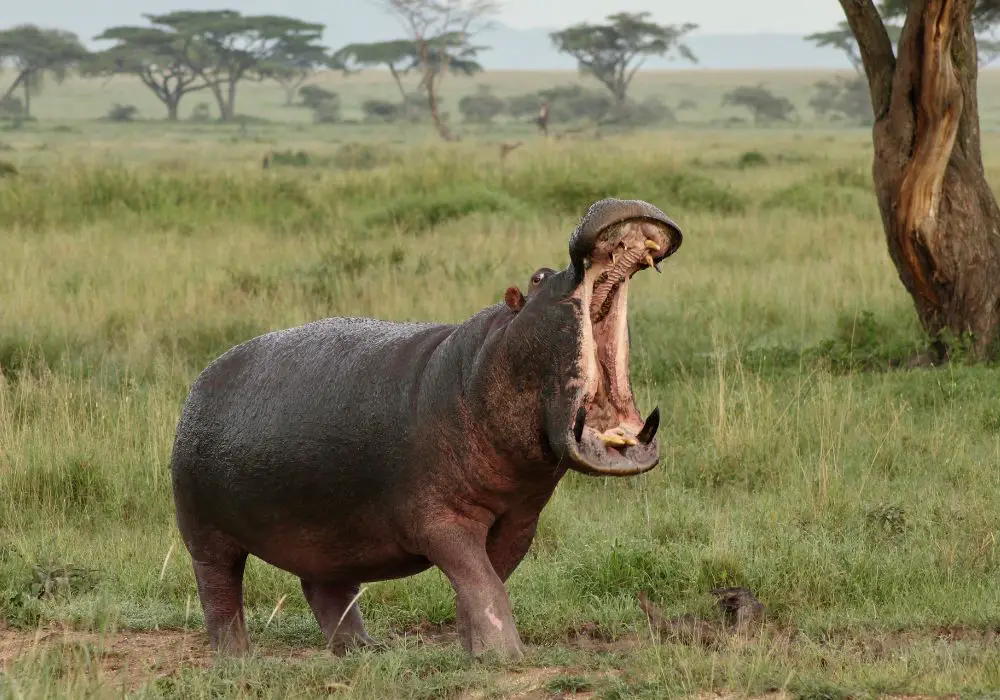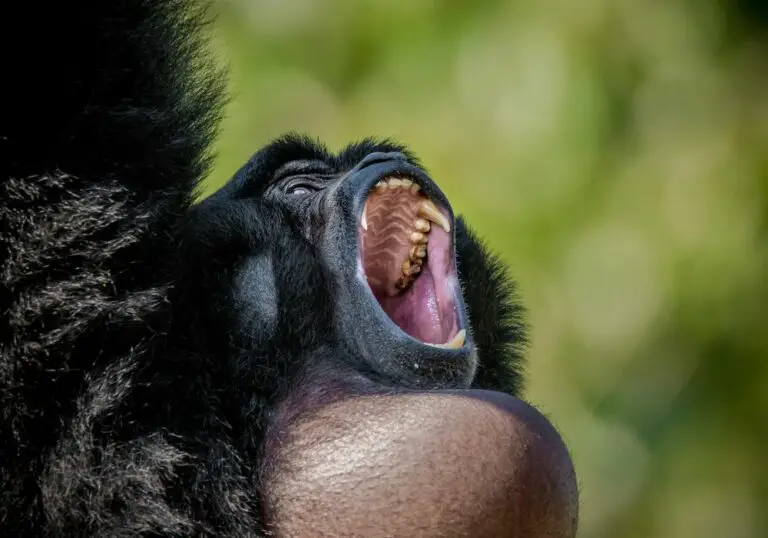Did you know that hippo is the third largest land animal, next to elephants and white rhinos? Yes, these semi-aquatic mammals can reach lengths from 9.5 to 16.6 ft., which is impressive.
Interestingly, most of us perceive hippos as cute animals, and if you open a children’s coloring book, they are painted as friendly and docile. However, that could not be further from the truth. You have probably noticed the large tusks emerging from their large mouth.
Well, they are not meant for cuddling or kissing; in fact, hippos have very interesting teeth! So, how many teeth do hippos have? Let’s check it out!
Hippopotamus Teeth: How Many Do They Have?
When you think about hippos, most people know that hippos are huge animals with very large mouths, which may indicate that these seemingly cute and chubby animals have a lot of teeth!
Well, that is not quite correct! Despite their spacious mouth, which can measure up to 4 feet when fully stretched, common hippos have around 36 teeth- only four more than we have!
The largest teeth are their tusks which are actually their canines and can grow up to 2 feet long but are generally around 1.5 feet; after the canines are their incisors, which are huge and can reach 1.2 feet.
As it happens in nature, males usually have bigger teeth than females. Hippos have 4 canine teeth and around 8 incisors, of which their lower incisor teeth extend forward.
They also have 12 premolars and 12 molars in the back of their mouth, used for chewing and gnawing food. Hippos’ molars and premolars, often called cheek teeth, are vital for their diet and survival.
If their molars get too worn out, they cannot use them to grind the grass, which may eventually lead to starvation.
Like most mammals, hippos go through two types of teeth, the milk teeth or deciduous teeth and the adult teeth. It happens that some adult hippos have more than 36 teeth, usually around 40 because they retain some of the milk teeth for a certain period.
What Do Hippos Eat?
Since we are on the subject of hippos and their interesting teeth, actually the biggest canine tusks on land (narwhals have 10 feet long teeth), it implied to discuss what they use their teeth for and what their diet consists of.
Hippos need teeth to chew and eat, but they are also handy weapons when fighting or defending territory. Interestingly, hippos are predominantly herbivores, meaning they eat grass, plants, and leaves.
In rare situations, hippos can be seen eating meat, or more precisely, carcasses of other animals. They are believed to resort to this behavior due to a lack of nutrients, especially during a dry season or opportunism.
As mentioned, they are semi-aquatic and spend most of their day chilling in the cold water.
When the night falls, it means dinner time for most hippos because they emerge to feed on grass and vegetation, which they pull with their lips, and gnaw with their flat molars.
Even though these animals mainly feed at night, they are not considered nocturnal but crepuscular.
Although they spend much time in the water, they rarely feed on aquatic plants. In fact, they eat approximately 80 pounds of grass every night, meaning they eat only around 1% of their total body weight.
How Strong is Hippos Bite?
Okay, the strongest bite force in the animal kingdom belongs to the Nile crocodile, but how strong is the hippo bite? Pretty strong! In case you are unfamiliar with the term, the bite force is measured in PSI or pounds per square inch.
Although their bite falls short when it comes to the Nile crocodile’s bite, which is the great 5000 PSI, these animals still have the bite force to bisect a human in half, which is 1,800 PSI or 12 400 kPa.
By comparison, a lion has around 650 PSI when it comes to bite force, while we (humans) have around 120-160 PSI, which pales in comparison with many animals. As mentioned, their mouth is around 2 feet long at its lip and measures around 4 feet when fully stretched.
These formidable crushing machines can inflict damage on rival hippos and other animals.
Are Hippos Aggressive? Do They Attack Humans?
When it comes to wild animals, especially those in Central and Eastern Africa, people are mainly afraid of lions, cheetahs, and rhinos. However, the real enemy is the hippo, contrary to everyone’s opinion.
These animals are highly territorial, which translates to aggressive, and that is why you will rarely see other predators, like lions or crocodiles, attempting to take down a hippo.
First, they are very large and thus hard to kill, but their nature is unpredictable, making them even more dangerous. Maybe a pride of lions will be able to kill a hippo, but even that attempt will not go without major casualties.
In addition, adult females are also naturally aggressive and territorial when defending their young ones! When it comes to aggression against humans, it is mainly defensive rather than unnecessarily destructive!
They rarely go out of their way to attack specifically humans, but you should not be near them at any time! You never know what may provoke them, and they do react when provoked, so you want to avoid that!
Also, hippos will defend their territory both in and out of water. Another common misconception about hippos is that they are slow! Although they look fat, they can run at 30 km/h or 19 mph. Outrunning a hippo is a tall order!
Fun fact: Hippos kill around 500 annually in Africa, much more than sharks!
What Are Hippo’s Teeth Made of? Do They Clean Them?

Hippo’s teeth are made of ivory! Can you think of another animal that is known for its ivory tusks? Who can it be other than an elephant! Ivory is a very precious but also durable material that consists of dentin, a calcified body tissue.
In addition to dentin, hippo’s teeth also have a layer of enamel, which is the outer protective covering of the tooth. Their tusks continuously grow, and hippos maintain their size and sharpness by grinding them against each other.
Their tusks or canines often break while fighting another hippo or defending their territory against other animals, which is usual. However, when it comes to captive hippos, this job is done by zoo keepers who use a special file!
Fun Fact: Considering that their teeth are made of ivory, they were used in dentures in the 18th century. In fact, there is a theory that George Washington, one of the Founding Fathers, had several sets of dentures made of hippo ivory!
Regarding oral hygiene, most animals have unique ways of cleaning their teeth and mouth, and hippos are no different! They have their own ‘fish and bird dental service!’
Given that they cannot brush their teeth but still need them to be cleaned, they usually leave that job to fish such as barbels, small carp-like freshwater fish. While in water, hippos get a full spa treatment, with these fish nibbling ticks, food residue, and parasites.
When on land, they have a different service for dental care; they rely on Oxpeckers, commonly known as tickbirds, which are small black birds with red-yellow beaks.
Do Poachers target Hippos?
Wherever you hear “ivory,” you can expect poachers to be involved. Unfortunately, due to their teeth, which are made of ivory, a very expensive and coveted material, poachers have been targeting hippos as an alternative source of ivory since the ban!
What kind of ban, you may ask? In 1989, the ban on the elephant ivory trade was passed, which meant that poachers needed to find another source, and the choice fell on hippos. Ever since hippos have been targeted for their meat and teeth!
Due to constant poaching, the destruction of their natural habitat due to human settlement, and pollution these animals are classified as “vulnerable” by the International Union for Conservation of Nature.
In the last decades, the hippo population has been decreasing greatly; it is believed that there may be around 115,000 adult hippos in the wild in Africa, but for the other range States, the number is even lower.
More Fun Facts About Hippos

Did you know that hippos’ closest relatives are whales and dolphins, known by their scientific name as cetaceans? Interestingly, most people think they may be related to pigs or horses, which is far from the truth!
That is not all; most cetaceans are carnivores, which is not the case with the hippo (partially). Then, there are only two species of hippos, the common hippo, and the pygmy hippo!
Although they do not seem athletic, they are excellent swimmers or, rather say, walkers, given that they usually walk on river beds. Also, they can easily hold their breath for over 5 minutes.
Conclusion
Hippos usually have 36 teeth, although some can have 40 because they keep their milk teeth longer.
However, eventually, those will fall out. In this article, we have covered some interesting information regarding hippo teeth, such as what their teeth are made of, how they clean them, whether they are aggressive, their diet, bite force, and some fun facts!
Do you think that hippos are scary? Please, share your opinion! If you have any comments, do forget to use the comment section!







